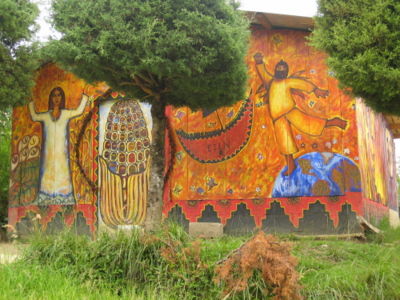Milpa agriculture
Milpa agriculture is a form of subsistence agriculture that is characteristic of Mesoamerica. Traditionally, a milpa plot was planted with maize, beans, and squash and often included scattered fruit trees, chilies and other plants. These plots were planted for two or three years and then allowed to lie fallow for some years in order to restore the fertility of the soil. Milpa agriculture has changed in a variety of ways in different areas but it remains an important part of life for millions of people throughout the region.
Maize and beans
Maize and beans, which are the staples of the Mesoamerican diet, complement each other in terms of the health of the fields as well as the health of the consumer. Maize requires high levels of nitrogen in the soil to grow properly and quickly depletes the soil if planted alone. Bean plants (genus Phaseolus), on the other hand, are high in nitrogen and their presence extends the life of the maize plot significantly by helping to keep nitrogen levels healthy. One might say that the maize repays the debt it owes to the beans by providing stalks for the bean plants to cling to as they grow. Squashes, generally grown between the rows of maize stalks, also benefit from this symbiotic relationship, as they benefit from the shade provided by the other plants.
Maize and beans also compliment each other nutritionally. If eaten alone, one would need to consume large amounts to fulfill human dietary requirements but when eaten together, they achieve "protein complimentarity."[1] That is to say, one needs less total food if the two are eaten together.
The ritual life of the milpa

Maize has a millennia old importance in Mesoamerican myth, ritual and culture.
In modern ritual practice, the agricultural cycle is filled with ceremonies that reaffirm the salience of corn as a cultural motif.
Modern trends
One consequence of the changes in land ownership patterns introduced through Spanish colonial society and some of the agrarian reforms carried out by the modern states in the region is that many families do not own enough land to produce all of the food that they need in a year. Consequently, the practice of fallowing the fields has disappeared or nearly disappeared in many areas. Today, many farmers use chemical fertilizers to increase their fields’ production and engage in other economic activities to earn enough money to provide for their families.
Many farmers have also converted their fields to other crops. Wheat was a popular cash crop in highland Guatemala until some time in the 1980s, when tariffs were lowered and the market was flooded with grain from the U.S., driving down prices. Today, cash crops destined for export to the U.S. include broccoli, snow peas, Brussels sprouts, and carnations.
Notes
- ↑ Edward F. Fischer and Carol Hendrickson. 2003. Tecpán Guatemala: A Modern Maya Town in Global and Local Context. ISBN 0-8133-3722-4
